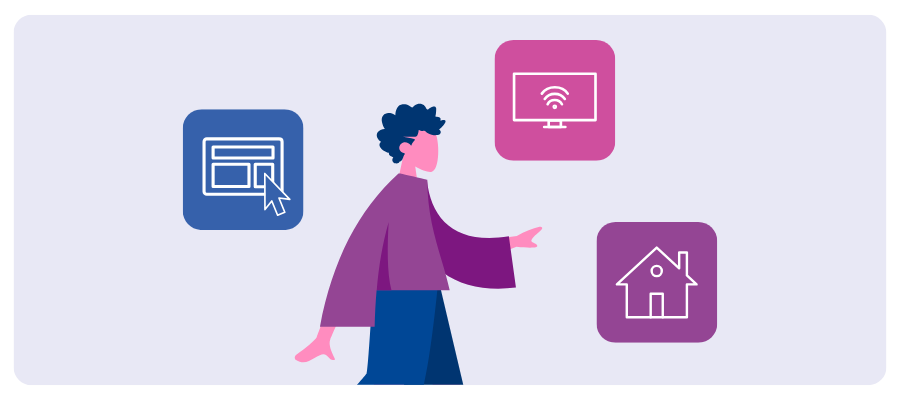At A Glance
As CTV viewership grows, marketers face challenges in targeting and measurement across fragmented platforms. Identity resolution and audience strategies, supported by Experian’s syndicated audiences and privacy-safe solutions, help DSPs and advertisers reach high-value audiences, improve campaign accuracy, and drive measurable outcomes.In our Ask the Expert Series, we interview leaders from our partner organizations who are helping lead their brands to new heights in AdTech. Today’s interview is with George Castrissiades, General Manager of Connected TV at AdRoll.
Premium reach and fragmentation
As viewer attention fragments across platforms, how should marketers redefine “premium reach” in CTV to prioritize engagement and audience quality over scale alone?

A few years ago, ad supported streaming over-indexed on younger adults, those without much financial history and much more budget conscious. It would have been fair for B2B brands to assume that maybe they weren’t going to find their C-Suite audiences on those channels, and so connected TV(CTV) was positioned as a top of funnel tactic aimed at retail. But that’s all changed – ad-free prices are going up, and ad supported tiers are the norm across the majority of channels. 66% of adults have at least one ad supported streaming channel, and adults today spend nearly as much time streaming movies and TV as they spend on their mobile phones. Now that ad viewing audiences on CTV really span the full spectrum of demo, techno, and firmographic segments, savvy marketers should partner with platforms that offer breadth and depth of targeting and measurement to find the highest value audiences wherever they’re watching CTV and serve them highly relevant ads that draw their attention towards the screen. I know I’m jumping out of my seat whenever I see an AdTech or MarTech ad.
Identity and relevance
What does a strong identity framework unlock for delivering household- and person-level relevance across screens, and how does it reshape audience planning?

In privacy-safe ecosystems, people want to share less data and log in to websites and browsers less frequently. If you can’t resolve a household ID to a CTV device through Safari and other sources of obfuscated identity, you’re going to end up losing a lot of signal along the way. On top of that, targeting smaller, higher-value audiences means this attrition can have a profound impact on your ability to build meaningful reach and use audience forecasts to predict scale. A strong identity framework is the key to maintaining as much of your planned audience as possible and staying true to initial forecasts.
AI and outcome planning
How is AI evolving CTV from tactical bidding to strategic outcome planning, and what mechanisms are in place to validate true performance lift?

Tomorrow isn’t guaranteed, especially not in advertising. Audiences change where and when they consume media, and so shifting budget to a placement that did well yesterday is like buying a stock when it’s outperforming – the gains might be gone by then! Predictive AI is bridging the gap to find the highest value and most engaged audiences in real time, versus being purely reactive. This helps drive outcomes which we see in the form of pipeline influence, ROAS, and site traffic lift – without exponentially increasing costs. The same is true for account-based marketing(ABM) outcomes – there’s a blend of signals, account “fit” and intent data that needs to be evaluated in a deeper, more intelligent way. AI is helping to find those highest value accounts, even before they’re in market, which means smart marketers aren’t showing up late to the party.
Measurement and incrementality
What privacy-safe, closed-loop measurement frameworks should become standard to prove incremental visits and sales from CTV campaigns?

Working with a dedicated multichannel, full-funnel ad and marketing platform like AdRoll can easily let you know when a user arrives at your site and makes a purchase, but understanding how that customer arrived there and which tactics deserve the credit requires a deeper, more sophisticated workflow. Our partnership with Experian allows all devices in a household to ladder back up to a household ID, so we can ensure accuracy without pivoting on anything personally identifiable. This works perfectly in CTV, an environment that follows an app workflow of user resettable device IDs rather than IP address or email but always connects seamlessly to web tokens including cookies. Accuracy, scale, and privacy are maintained in a proven way – you see this tech underpinning the infrastructure of streaming across all the biggest players, so marketers can rest easy.
Creative and commerce
How can creative sequencing and shoppable TV experiences convert living-room attention into commerce without compromising user experience or feeling intrusive?

I like to say that CTV trades attention for action. Users lean back and focus on the messaging and visuals of the big screen rather than scrambling for the mouse or tapping to close some intrusive pop-up. This focus means that the messaging is absorbed more quickly, but creatives can wear out their welcome just as fast. Sequential messaging really helps to move the messaging along without subjecting the viewer to longer ads where attention wanes, but also increases brand recall and specific product information because the story evolves with each impression. This is a great tactic to use when you want a viewer to take a specific action later – but shoppable ads can help motivate a user to act now, and new formats can really simplify things. Shoppable can feel out of range for most – the top players in this space own major e-comm storefronts and then tie them back into their own demand-side platforms (DSPs), content, and streaming devices. For the rest of us, dipping our toes in slowly through simple and cheap solutions like QR codes can connect audiences right to a web experience from their TVs, or intermediate solutions like interactive video ads. Users love to play around with fun on-screen experiences, and there’s a whole spectrum of crawl/walk/run options available.
Trust and governance
Which shared guardrails—brand safety, fraud control, and frequency management- are essential to unlocking sustainable, scaled investment in CTV?

I’ve always thought of CTV inventory analogously to high-end watches – if you buy from the source or a well-known, reputable dealer, you’re probably buying the real thing. But that fancy timepiece the guy was selling outside the bar, that you swore looked real? Probably not. Untrusted resellers and too-good-to-be-true pricing might mean you’re running ads on a screen at a lonely gas station at 3 am to an audience of no one, and that’s not even the worst case scenario. Good relationships and deep pockets can solve brand safety and fraud issues, but not every advertiser is going to have those resources. Brand safety and fraud prevention can reduce workload and help distinguish the good stuff from the growing pool of gray area, arguably, CTV inventory that isn’t what was promised to a customer. Outsourcing this trust also goes a long way, with buyers knowing you’re not grading your own homework. Frequency management is equally as important. Once you have your audience and your good supply, it’s important not to abuse a single household just because they meet your targeting criteria. Reach is your best friend with CTV.
Data and audience strategy
How do Experian’s syndicated audiences provide a consistent, scalable foundation for planning, activation, and measurement across CTV and digital, and what outcomes are clients seeing?

We love to talk about how Experian’s data is such an integral part of so much of streaming’s architecture, and the fact that it’s built on deterministic datasets means you’re getting scaled audiences built on knowledge rather than best guesses. That means a lot when working across multiple channels, privacy-safe environments, and households with an ever-growing number of connected devices. Our customers are always delighted at how precise targeting can be, especially in the B2B/B2C space – and knowing the size of those audiences helps them to understand how budget transforms into reach in a more predictable way. It’s confidence-inspiring to point to a new audience and tell your client that these are their future customers. The best part is showing them the outcomes reporting – we consistently see a massive spike in site traffic and engagement on days when a new Experian syndicated audience is launched!
Contact us
FAQs
Identity resolution ensures marketers can connect devices and maintain audience accuracy. Experian’s identity solutions help reduce data loss and improve audience forecasts, making campaigns more effective.
With viewer attention spread across platforms, marketers need tools that offer both broad and detailed targeting. Experian’s syndicated audiences provide reliable, scalable data to help identify and reach high-value audiences across channels.
Techniques like sequential messaging and shoppable ads keep viewers engaged and encourage action. Simple tools like QR codes or interactive video ads can connect audiences to web experiences directly from their TVs.
Strong identity frameworks help DSPs maintain accurate targeting and audience reach, even in privacy-focused environments. By connecting devices to household IDs, solutions like Experian’s Digital Graph ensure DSPs can deliver relevant ads and measure performance effectively across channels.
About our expert

George Castrissiades
General Manager of Connected TV, AdRoll
George leads the CTV go-to-market strategy at NextRoll, driving rapid growth and adoption of the channel for both B2B and B2C customers. With a track record of building and scaling CTV solutions, he is focused on developing a strategic playbook that accelerates success in the evolving digital advertising landscape.
Before joining NextRoll, George spearheaded CTV product innovation at iSpot.tv and held leadership roles in product and operations at YouTube, VICE Media, Crackle, Roku, and Innovid. His expertise spans product development, monetization, and market expansion.

About AdRoll
AdRoll is a connected advertising platform built for growth-minded marketers. With powerful AI, flexible campaign tools, and seamless integrations, AdRoll helps mid-sized businesses turn complexity into clarity and clicks into customers. The AdRoll platform delivers full-funnel performance through multi-channel advertising, audience insights, and cross-channel attribution, supporting marketers across industries including ecommerce, technology, financial services, education, and more. For B2B teams, AdRoll ABM extends these capabilities with account-based precision, multi-touch campaigns, and real-time buyer intelligence. Backed by nearly 20 years of data and award-winning support, AdRoll enables marketing teams to advertise smarter, move faster, and achieve more, all from one place.
Latest posts

Strong Revenue Performance and Thriving Culture Contribute to Industry Recognition NEW YORK, Sept. 15, 2016 /PRNewswire/ — Tapad, the leader in cross-device marketing technology and now a part of Experian, was named a top company on Inc. Magazine’s list of the 5000 fastest-growing private companies in the U.S. In addition, Tapad won the TMCnet 2016 Tech Culture Award. The exclusive Inc. 5000 ranking highlights the fastest-growing privately-held* companies in America. These distinguished companies have achieved success in strategy, service and innovation. TMCnet recognizes talented tech professionals who are committed to building a culture that prioritizes employee growth, collaboration and engagement. Tapad continues to broaden their presence into new markets, having launched in APAC earlier this year, as well as continuing their European expansion. Tapad’s proprietary technology, The Device Graph™ is leveraged by more marketers and brands to understand digital engagement across devices. The company’s rapidly expanding client base includes numerous Fortune 500 company brands as well as all four major advertising holding companies in the U.S. “We have an exceptional team of innovative people who are all working very hard to achieve the kind of results these publications are recognizing,” said Tapad CEO and Founder, Are Traasdahl. “Given that, we have an even greater responsibility to our talent to create an environment that fosters innovation and nurtures open communication. Ultimately, this is how we will continue to reach our very ambitious goals of becoming the world’s leading unified marketing technology provider.” Tapad’s award-winning work culture is defined by its gold-standard benefits which include a six-month parental leave policy, unlimited vacation time, company-sponsored meals and office space designed to facilitate collaboration and open communication. Tapad’s highly talented team has also received multiple customer service awards in 2016. These awards include the iMedia ASPY awards for Best Customer Service and Best Mobile Partner as well as recognition from The Communicator Awards of Excellence in Interactive Media. *Prior to Tapad’s acquisition by Telenor in February 2016. Contact us today

The Tapad Device GraphTM Had Twice the Precision and Three Times the Scale as Next Competitor New York, September 14, 2016 – Just-released findings of a Hotels.com® study revealed that Tapad’s (part of Experian) cross-screen marketing technology achieved the highest levels of precision and scale among competitors. According to the leading online accommodation booking website, after a rigorous, three-and-a-half month vendor analysis, Tapad achieved twice the precision of the next highest-scoring cross-screen offering and three times greater scale. The two other companies evaluated were not named. Said Helene Cameron-Heslop, Senior Manager of Analytics of the Hotels.com brand, “Our team implemented an extremely rigorous vetting of open, cross-screen technology vendors. At the outset, we assumed we would have to compromise on either scale or accuracy – particularly given the importance to our brand of operating in a privacy-safe setting. We were surprised to find a complete package, but Tapad’s Device Graph won out on scale, accuracy and privacy; making our choice of partners very clear.” In another metric critical to the Hotels.com brand, The Tapad Device GraphTM was eight times more “unique” than the next closest offering, meaning Tapad’s graph was found to have a much greater number of connections not seen in any of the other graphs. In addition to precision, uniqueness and scale, the Tapad Device GraphTM was found to have: ● 100% higher recall● 47% more incremental matches● 53% higher North American market coverage● 101% higher F-Score* “A valuable cross-device solution should enable partners to get everything they’re looking for from a single vendor,” said Tapad Founder and CEO, Are Traasdahl. “We are deeply impressed with how thorough Hotels.com was in their vetting, and we confidently tackle the complex challenges of the martech industry thanks to our superior technology. Everyone loves a bake-off, and Tapad is no exception – delivering best-in-class results in areas that really count.” *F-score is a statistical measurement that takes precision and recall together. The calculation is 2*(precision*recall)/precision + recall). It gives you one number instead of two numbers to look at and judge performance. Contact us today

Five Norwegian startups selected to establish U.S. presence NEW YORK, Aug. 15, 2016 /PRNewswire/ — Tapad, the leader in cross-device marketing technology and now a part of Experian, has announced its new entrepreneurial mentorship initiative, the Propeller Program. Five early-stage startups from Norway have been chosen by Are Traasdahl, native of Norway and Tapad’s CEO and founder. The selected companies will share Tapad’s New York City workspace, receive C-level guidance and help establish a U.S. presence. The following companies have been selected to participate in the inaugural Propeller Program – a 12-month program beginning September 19, 2016: Bubbly – Developers of a platform that enables in-store customer feedback with dashboards and tools that facilitate real-time store response BylineMe – A marketplace for freelancers, publishers and brands to connect for content creation and distribution services Eventum – A property-sharing group that digitally assists in securing venues for meetings and corporate events Xeneta – A database that organizes the best contracted freight rates in real time and on demand “We are supporting startups that we feel represent the future of service offerings,” said Traasdahl. “It is with incredible pride that we invite these entrepreneurial teams from Norway to join us in New York Citythis year. Mentorship opportunities for early-stage companies are so important, particularly for those based outside the U.S. I look forward to giving the Propeller Program participants access to the expertise of my seasoned team and to our wide network of resources. Hopefully, it will be a game-changing year for many of them.” Contact us today